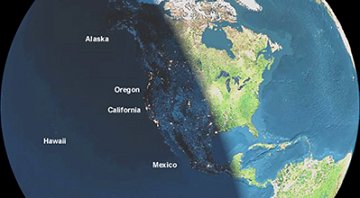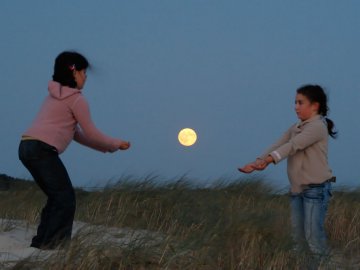 Where's Saturn? Is that a UFO--or the ISS? What's the name of that star? Get the answers from mySKY--a fun new astronomy helper from Meade. Where's Saturn? Is that a UFO--or the ISS? What's the name of that star? Get the answers from mySKY--a fun new astronomy helper from Meade. METEOR UPDATE: "One of my meteor cameras was pointing northeast this morning and captured an Aurigid meteor," reports astrophotographer John Chumack of Dayton, Ohio: image, movie. This early activity may bode well for Saturday morning's predicted display, detailed below. "We will soon see if this ancient comet debris trail ends up providing us a nice meteor shower." WEEKEND METEORS: This weekend, Earth will orbit through a stream of dusty, rocky debris shed by ancient Comet Kiess. What will happen? Some forecasters expect a colorful meteor shower over western North America around 4:30 am PDT on Saturday, Sept. 1st. This is how Earth will look at the time of the peak: 
Darkness favors observers west of the Rocky Mountains. If you're in the zone of visibility, start watching around 3:30 am PDT and keep watching until dawn. Many dozens of meteors could come streaming out of the constellation Auriga: sky map. On the other hand, the Aurigid shower could be a dud. Comet Kiess' debris trail is so old (~two thousand years) it might be empty, resulting in few or no meteors at all. Consider your sky watch a journey into the unknown! Researcher Peter Jenniskens of the SETI Institute hopes many people will observe and take pictures. He offers this example of a meteor he caught in March 2007 using a Nikon D50 (ISO 1600, 30s). "We would like people to use similar digital cameras to take pictures of the Aurigids," he says. " We can use the red, green and blue parts to study some aspects of fragmentation. We also want to know what was the brightest Aurigid observed." [photo tips and submissions] MOON GAMES: "We couldn't see Tuesday's lunar eclipse from Europe, so my girlfriend Sabine and our children decided to play some Moon games on the beach," says photographer Laurent Laveder of Bretagne, France. He snapped this picture using his Canon 30D at ISO 800: 
Click here for more photos
"It was a nice opportunity for a quick lunar soccer match and for Sabine to sit down comfortably reading a book beneath the electric Moon." Just one piece of advice for the kids: Don't drop that ball. It weighs about 150,000 billion billion pounds (7x1022 kg). Lunar Eclipse Photo Gallery
[Night-sky Cameras] [Interactive Eclipse Map] | 
